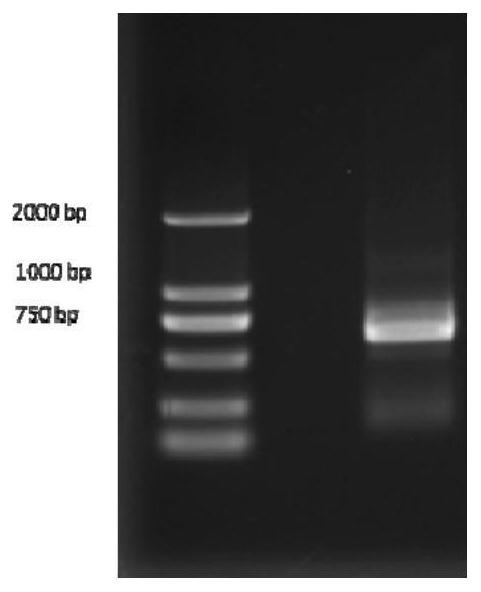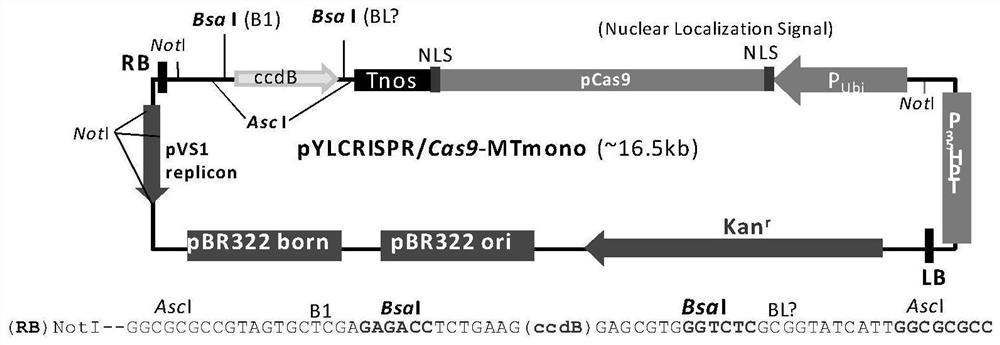Method for preparing photosensitive male-sterility material of rice and related gene
A male sterility and photosensitive technology, which can be used in botany equipment and methods, biochemical equipment and methods, genetic engineering, etc., and can solve problems that have not yet been discovered
- Summary
- Abstract
- Description
- Claims
- Application Information
AI Technical Summary
Problems solved by technology
Method used
Image
Examples
Embodiment 1
[0101] Example 1, Selection of Rice RMS1 Gene Target Site and Construction of Knockout Vector
[0102] The inventors of the present invention discovered a gene related to photosensitive male sterility—the RMS1 (Reverse Male Sterility) gene from rice Wuyunjing 7. Wherein, the coding sequence of the RMS1 gene is shown in SEQ ID No.2 in the sequence listing, encoding a protein RMS1 consisting of 345 amino acid residues, and its amino acid sequence is shown in SEQ ID No.1 in the sequence listing. The gDNA of the RMS1 gene has a full length of 2623bp, contains 3 exons and 4 introns, and its nucleotide sequence is shown in SEQ ID No.3 in the sequence listing.
[0103] In this example, the rice RMS1 gene was knocked out by CRISPR / Cas9 gene editing technology to obtain mutant 9522 with a photosensitive male sterile phenotype 38740-4 、9522 38740-5 and 9522 38740-11 , mutant 9522 38740-4 、9522 38740-5 and 9522 38740-11 All RMS1 gene knockout rice. The specific operation method is...
Embodiment 2
[0123] Example 2 The acquisition of RMS1 mutant rice material and its phenotype analysis
[0124] 1. Obtaining RMS1 mutant rice materials
[0125] Using the method of Agrobacterium-mediated transformation of rice callus, the RMS1 gene site-directed editing vector pYLCRISPR / Cas9-MT-RMS1 was used to transform the callus of rice variety Wuyunjing 7 (formerly coded as 9522, hereinafter referred to as 9522), and screened. Positive mutants were identified.
[0126] 2. Detection of fixed-point editing
[0127] Homozygous mutants of the three types of mutations in which the RMS1 gene was knocked out were obtained by PCR detection, and they were named homozygous mutants 9522 38740-4 , homozygous mutant 9522 38740-5 , homozygous mutant 9522 38740-11 . The sequencing results showed that (such as Figure 6 Show):
[0128] RMS1 gene (wild type) in homozygous mutant 9522 38740-4 There was a mutation in the RMS1 gene CDS 128-129 missing 2 bases, which resulted in a shift of the RMS1 ...
Embodiment 3
[0139] Example 3 Analysis of photosensitivity characteristics of RMS1 mutant rice materials
[0140] 1. Analysis of photosensitivity characteristics of RMS1 mutant rice materials
[0141] RMS1 mutant material homozygous mutant 9522 planted under natural conditions in Lingshui, Hainan (18°51′23″N, 110°5′6″E) 38740-4 T 2 generation, homozygous mutant 9522 38740-5 T 2 generation and wild-type rice 9522, it was found that the homozygous mutant 9522 38740-4 T 2 generation, homozygous mutant 9522 38740-5 T 2 The seed setting rate of generation plants was low, 4.56% and 3.13%, respectively, while the seed setting rate of wild-type rice 9522 was 95.6% (201812-201904); ) under natural conditions to grow the homozygous mutant 9522 38740-4 T 3 generation, homozygous mutant 9522 38740-5 T 3 generation and wild-type rice 9522, it was found that the homozygous mutant 9522 38740-4 T 3 generation, homozygous mutant 9522 38740-5 T 3 The seed setting rates of the first generation...
PUM
 Login to View More
Login to View More Abstract
Description
Claims
Application Information
 Login to View More
Login to View More - R&D
- Intellectual Property
- Life Sciences
- Materials
- Tech Scout
- Unparalleled Data Quality
- Higher Quality Content
- 60% Fewer Hallucinations
Browse by: Latest US Patents, China's latest patents, Technical Efficacy Thesaurus, Application Domain, Technology Topic, Popular Technical Reports.
© 2025 PatSnap. All rights reserved.Legal|Privacy policy|Modern Slavery Act Transparency Statement|Sitemap|About US| Contact US: help@patsnap.com



